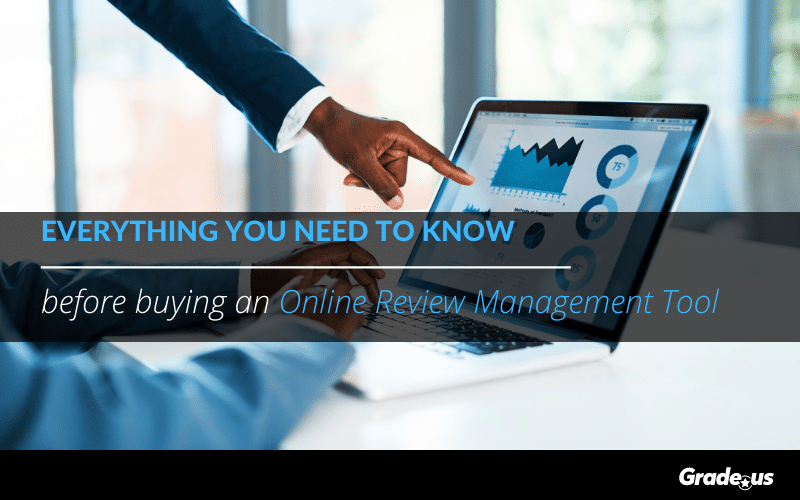Online reviews are very profitable.
Researchers at Womply found that businesses with more than 82 reviews (overall) earn 54 percent more in annual revenue than their competitors.
Here’s the problem.
It’s difficult managing your review management campaigns manually. As your business grows, it’s going to become increasingly difficult to manage your reputation.
You’re going to need help.
Schedule a Grade.us Overview
Why you need review management tools
Customers tend to create lopsided review portfolios.
When it comes to writing reviews, your customers need your care, guidance, and protection. This isn’t you coaching your customers on what to say or how to say it. It’s giving your customers the structure they need to say whatever they want to say.
Often times they struggle.
- Customer reviews are lopsided: If they prioritize reviews, they often focus their attention on a specific review site or platform. They’ll go all-in on Yelp and Google Reviews, but they’ll ignore TripAdvisor. This imbalance means your search visibility decreases, and fewer customers see their reviews.
- Customers don’t know what to say: They’re happy and satisfied with your service, they’d be willing to write you a glowing review if only they knew what to say. They’re embarrassed to admit it when you request a review, so they ghost you. They’d rather not admit that they’re struggling to put their thoughts into words.
- Your product or service is uncomfortable: Some products are taboo or embarrassing — hemorrhoid creams, condoms, lice shampoo. Services have hidden indicators that customers may find hard to reveal (i.e., personal training = previously overweight); some customers won’t mind, while others may be hesitant to reveal key details.
- Companies ignore review indicators: They avoid looking at consistent objections, problems, challenges, and frustrations in customer reviews. They don’t have a plan to address these issues, and they don’t want one. As a result, their reviews fall to boost revenues the way they should. Customers aren’t as satisfied as they should be. This creates a bias where customers repeat the issues previous customers brought up in their reviews, with more vitriol.
Structure eliminates these problems.
When you create structure, you give your customers the tools they need to tell the world, for better or worse, how they really feel about your products and services.
What kind of structure?
- Consistent review requests that are sent on a schedule. These requests could be sent # days after their purchase or service request.
- You ask customers specific questions about their experience with you, giving them the clarity they need to recall the precise detail of their experience.
- You direct the right mix of customers to the review platforms you need, so future customers see you on each of the sites they’re already using.
- You use triggering events and changing circumstances to boost review generation (e.g., these reviewers are blackmailing us with fake reviews, would you be willing to share your review). It’s your birthday, what did you think about
See what I mean?
You’re guiding customers, providing them the tools they need to share their feedback, but you’re doing it in a way that’s free from coercion, manipulation, or anything sketchy.
What you need to know before you buy a review management tool
You’re simply gathering information here.
You’ll want the answers to easy questions like:
- The makeup of your businesses
- Your expectations from review management
- How you’ll measure the ROI of review management
- Your review management procedures (who’s responsible for requesting, responding to, managing, and promoting reviews)
The tool you select should work within these requirements, never against them.
Let’s take a closer look at these.
1. The makeup of your business
The needs of a franchise are very different from a multi-location business or SMBs. You’re going to need to have a clear chain of command. You’ll need specific procedures in place to make sure that each franchisee sets their review profiles up the same way, that it’s optimized around the right phrases and that reviews are assigned to the right location.
For example, each review site profile should be optimized. This means you’ve added:
- NAP (name, address, and phone)
- Photos + videos
- Question and answers or FAQs (where relevant)
- Descriptions
- Keywords + tags + categories
- Hours of operation
- Website address
- Booking or appointment URLs (if applicable)
- Tracking details (e.g., discount/store codes, ad extensions, call tracking phone numbers, labels, etc.)
- Call to action
- Balanced reviews (5:1 ratio)
To every profile.
The last thing you need is the negative reviews from some other franchisee.
You’ll need to verify that your review management tool can manage your specific business/business model. It doesn’t matter if you’re running an agency, franchise, multi-location, enterprise, or SMB. Your tool should be able to handle the tasks you throw at it.
2. Your expectations from review management
First, you’ll need to identify your expectations; is it increased search visibility, more traffic, conversions, revenue, and customer feedback?
Next, you’ll need to identify whether your expectations are:
- Fuzzy: If you’re saying that you kinda sorta have this rough idea of how your review management campaigns should go, but you don’t have all of the details yet; if you’re using the phrase “I’ll know it when I see it,” your expectations are probably fuzzy.
- Implicit: These expectations rely on assumptions. You assume that everyone on your team would know XYZ. You don’t want to be condescending. “Of course marketing will manage and respond to reviews! Isn’t that common sense?” These unspoken expectations lead to disaster when they’re unmet.
- Unrealistic: Your expectations are somewhat or completely unrealistic, i.e., we only have 150 customers, but customer reviews will triple our revenues this year!
- Realistic: Specific, quantifiable, and attainable goals that are based on reasonable and experienced projections. These goals are documented, explained thoroughly, and understood by the entire team.
What are some examples of realistic goals?
- Requesting a review from every customer once their order is complete
- Sending out automated review requests three times total to every customer
- Responding to every customer review within 24 hours
- Promoting our 3, 4, and 5-star reviews on our website, marketing materials, and in our social media campaigns
- Tagging all links with the right tracking parameters
- Optimizing review site profiles, so they’re more visible in Google’s search results
- Set performance benchmarks then work to beat them by at least 10 percent quarterly
See what I mean?
There’s no ambiguity with these goals; they’re clear, easy to understand, and simple to execute.
3. How you'll measure the ROI of review management
Research from Moz found businesses risk losing as many as:
- 21.9 percent of customers if you have just one negative aggregate review listed on page one of Google
- 44.1 percent of customers if you have two negative results
- 59.2 percent of customers with 3 negative results
- 69.9 percent of customers with 4 negative results
That’s a significant drop in search engine traffic. Let’s look at an example:

This business has not one but two negative aggregate ratings displayed in Google’s search results. That’s a significant loss to this business.
How bad is it?
Let’s do the math to find out. We’ll use this data for our formula.
Y = X / (100 – X)
Y = How many more customers you could have had (as a percentage)
X = Average percent of lost customers for businesses like yours
Where are we going to get X? From the data provided by Moz! If you have one negative result, X would be 21.9 percent. If it’s two, 44.1 percent, and so on.
Your formula would look like this:
Y = 44.1 / (100 – 44.1)
This means Y = .79 or 79% more business!
This is a significant loss.
The good news with this example is that it’s not your loss. Using this formula, you can calculate your projected return ahead of time. This is a great example that demonstrates why having a strong review portfolio across multiple review sites (e.g., Yelp, Google, TripAdvisor, Facebook, etc.) is so important.
Try it free: Build an amazing portfolio of 4 and 5-star reviews in 60 days or less with Grade.us; our tools make review management easy, simple, and automatic. Try it free for 14 days; no credit card required.
4. Your review management procedures
You’ll need to know who’s responsible for requesting, responding to, and managing, and promoting your reviews.
What about error correction?
Who’s responsible for addressing your customer’s macro, meso, and micro level complaints? If customers complain about fulfillment, service quality, or wait times — do you have a process in place to make the necessary changes and improvements?
How is that routed through your organization?
What about the complaints and objections that appear in reviews? Who’s responsible for handling those? How is the team notified? These are the details you’ll need to identify ahead of time.
Here’s a quick review management governance checklist you can use to build out your process.
- Decide who is in charge of review management. Is it your customer support team, your marketing dept., business owner, or marketing agency?
- Create review management protocols. If you’re using review management software like Grade.us, you’ll want to set up notifications for each of the review platforms you’ve listed earlier, so they’re able to respond to reviews as they come in.
- Create employee incentive programs. What can you do/offer to motivate employees, so they’re more willing to request reviews? Which employees can participate?
- Create a response policy. Which reviews do you respond to (all, positive, negative, neutral) and when? Will you provide employees with scripts and templates they can use? Are they free to respond as they need to, or do they need to answer specifically as outlined in your documentation? What should the overall tone of their responses be? How much authority will responders have/receive to solve/resolve customer concerns?
- Set reporting guidelines. Create a review reporting plan outlining which managers or executives will receive the reports. Which reviews (e.g., positive or negative) will be shared with employees? Will employees in your incentive program receive more data than those who are not participating?
- Set distribution guidelines for incentives. Determine when employees receive review generation incentives. Are incentives distributed privately, publicly (inside the company?)
If you have a general idea of these items, shopping for review management is easy.
Know what you're getting with your review management tool
Here’s a short checklist of the items you can use to vet the tools you’re considering.
- Look for companies that have good product/customer fit. Are the tools you’re considering designed for your business model?
- Verify that the essential features (review funnels, review requests via email, txt, direct mail, review monitoring and responses, review marketing, and reporting) are all included.
- Look for must-have integrations. If you’re using software like QuickBooks, MailChimp, Salesforce, HubSpot, or Zapier, you’ll want your tool to integrate with these. This includes API access.
- Look over the review site policies of your review management vendor. For example, some review sites prohibit review gating; others prohibit review requests entirely. Does your tool of choice accommodate these rules on a per-site basis? They should.
- Scrutinize vendor customer reviews. Do they have a strong review portfolio? Are they visible on sites like G2, Capterra, or Software Advice? Do they have strong reviews and satisfied customers? You’re looking for a 5 to 1 ratio; you should see five positive reviews for every negative review.
- Your vendor should be able to verify your total cost of ownership; meaning, they should be able to provide you with an estimate for any additional training, add-ons, resources, or education required.
These details aren’t complicated; they just take a little bit of time.
This is crucial.
As you go through the sales process, remember this adage: How they sell you is how they’ll serve you.
Are they attentive?
Or do they behave as if they’re doing you a favor by taking your call? You’ll want to monitor these details ahead of time. Details like the number of innovative features aren’t as important as the items we’ve discussed above.
Make sure your vendor is a match.
Your online reviews will be profitable
Finding the right tool (product) begins with the right people, process, and policies. As your organization grows, managing your review management campaigns can become simple and precise. Use the tips and tactics I’ve shared with you today to find the right review management tool for your company.
With the right tool, you’ll find online reviews are extraordinarily profitable, as they should be.
Try it free: Turbocharge your Google, Facebook, Yelp, and TripAdvisor profile with Grade.us; our tools make review management easy and automatic. Try it free for 14 days; no credit card required.









